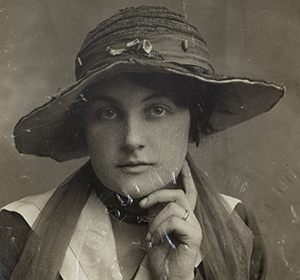Ireland’s US Navy ‘war brides’
Published in Issue 4 (July/August 2017), News, Volume 25US Military in Ireland Centenary Project.
By Damian Shiels

Above: Veronica Dillon from Whitegate, Co. Cork, daughter of an RIC constable. She was 21 years old when she had this picture taken for her application in 1919. In it she wears a US Navy sweetheart pin given to her by her New Yorker husband, Frank Harris, a US Navy chief electrician. Veronica spent the remainder of her life in the United States. (National Archives and Records Administration)
The arrival of large numbers of Americans in early twentieth-century Ireland represented a major culture shock for both the sailors and the locals, something on which numerous servicemen commented in their letters home. William Hoffman of the USS Oklahoma in Bantry Bay confided to his father that ‘the people seem odd and talk funny … you can’t hardly understand a word they say’, while Thomas Bedner of the US naval base at Aghada remarked that ‘we take long walks and visit some of the queer old villages … in some of the places they never saw a “Yank” before. As soon as they see one or a group of us passing there is a general popping of heads out of windows as if there was a circus coming.’ Aside from the cultural differences, Americans also remarked on the poverty. Lt John Herlihy from Fitchburg, Massachusetts, told his brother that ‘after seeing how people have to live in this part of the world and what little they have to be glad about I am fully convinced that a man in the States even working for a salary is better off than a man with money over here …’.
The combination of cultural, financial and, increasingly, political differences led to growing hostility towards the Americans. Warnings from the pulpit spoke of how the sailors were ‘preying upon the purity of our daughters’. This animosity spilled over in Cork City, where a series of violent attacks on US sailors and their Irish girlfriends took place. These incidents led the US Navy to permanently ban the majority of their servicemen from entering the city. Even that was no guarantee of avoiding confrontation; on another occasion a group of women who travelled to Queenstown (Cobh) to meet American sailors were attacked at the station by young men ‘armed with sticks and stones’.
In contrast to how these relationships were often viewed at home, the Irish women who married Americans usually met with a positive reception in the United States, where European ‘war brides’ were a source of pride. The relationships were lauded in the press, under headlines such as ‘COLLEENS WIN AMERICAN TARS’. Newspapers like the St Louis Post-Dispatch opined that ‘after the war, every part of the United States from Maine to California, and from the Great Lakes to Florida, will boast of an Irish bride who was wooed and won in her native land by an American sailor’. The Washington Times was among those to report on the supposed superiority of Irish brides in contrast to others from Europe, stating that ‘the highest average of comeliness is among the Irish brides. Few of the girls are of the high-heeled variety, the majority having efficient acquaintance with household duties. The girls themselves are unanimous in pronouncing Americans persistent and gallant lovers.’
While many of the women would have had the blessing of their families at the start of their new lives in America, some marriages would undoubtedly have been viewed disapprovingly. A number of them carried the added burden of having to endure the social consequences of pregnancy outside wedlock in early twentieth-century Ireland. In an effort to uncover something more of their personal stories, the US Military in Ireland Centenary Project sought to identify as many of these women as possible through the passport applications they made at American consulates in Ireland and Britain prior to their departure. Aside from providing much detail about the women’s background and marriage, these forms bring the added bonus of including often remarkable images of each of the Irish brides.
To date, the project has uncovered almost 100 Irish ‘war brides’. Unsurprisingly, the majority of them came from Cork City and Queenstown, though at least one was identified from every locality where Americans were based on the island during the war. Ongoing work on the demographics of the women indicates that the majority were under 22 years of age; they came from a range of backgrounds, with the daughters of labourers, tradesmen and military/police the most common. Most hoped to make their new lives on the east coast, particularly in New York, Massachusetts and Pennsylvania. Though not all of these young Irish women had happy endings with their American sweethearts, many certainly did. On the occasion of the centenary of the American entry into the war, their considerable courage in leaving everything they knew behind to seek a new life across the ocean is one that deserves to be remembered.
Damien Shiels is curator of ‘Portraits: Women of Cork and the US Navy 1917–1919’, which runs in the Sirius Arts Centre, Cobh, until 17 September 2017.


















